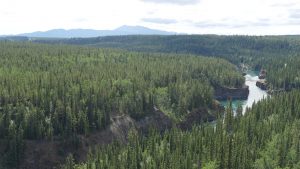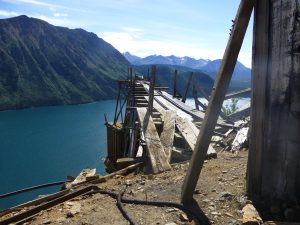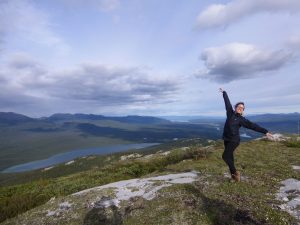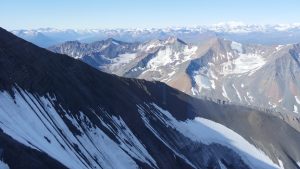
This post is a reflection of my own personal experiences and it is not my intention to make generalizations about life in the Yukon or in the North.
Before I left for my internship, I received a lot of unsolicited well-meaning advice about what Northerners were like, how expensive my groceries were going to be, and how to handle bear attacks. Luckily, I never had to figure out that last one (although I did have a few close encounters with large foxes). Thinking about the Yukon conjured images of Ted Harrison’s colourful and vibrant artwork[1], a few vague historical facts about the Gold Rush, and the line from Robert Service’s famous poem, The Cremation of Sam McGee: “There are strange things done in the midnight sun…”[2]. People’s reactions when they learned that I would be spending some time up North ranged from surprised and concerned to curious and confused. During my time in the Yukon, I was often asked by friends and family from back home: “So what’s it like, up North?”
I was excited to spend a summer in the Yukon; several years ago, I had travelled across the country for a Canada-wide art project without enough funding to make it to any of the Territories. I knew that the North was unique and that, as “southerners,” we are sometimes guilty of forgetting that it exists. I certainly do not remember learning much about the Yukon, other than a brief history of the Gold Rush, despite growing up in British Columbia.
So here are some of my personal observations during my summer in “the North.”
Interaction with wildlife is often a daily occurrence. The city of Whitehorse is small, and the various subdivisions are surrounded by forest. A few steps in any direction will take you on a back-country trail or into the woods. Foxes are often seen roaming the city. There are stories of wolves chasing road cyclists and dog-scaring porcupines. Whitehorse residents are frequently reminded to bear-proof their garbage bins and refrain from leaving out “attractants”. The number of bears that conservation officers have killed this year alone is a stark reminder that this land is not ours and that we are the intruders disturbing the animals’ habitats.[3]

Many locals that I met were very proud to call themselves “Northerners”. I learned that life up North can sometimes be very challenging and unforgiving due to extreme weather conditions, remoteness, and lack of resources. Early on in the summer, I arrived at the grocery store to discover empty shelves with no fresh produce and a simple note from the staff – it instructed customers to return in a few days because the produce truck had a flat tire and would not make its scheduled delivery time. Several locals explained to me that this was not an uncommon occurrence and that sometimes the trucks can’t make it in because the road is washed out due to weather. That being said, Whitehorse is one of the most Southern communities in the Yukon and quite easily accessible compared to fly-in communities in the Territory, such as Old Crow, where people who visit often bring fresh produce with them as gifts.
I experienced the infamous Northern hospitality from everyone I met – perhaps, due in part to the demands of life in the Yukon and in part to the nature of living in a small community. It started with my new roommate picking me up from the airport at 1:00 am. People were eager to show me around, lend me their outdoor gear, or share a meal. Everywhere I went I was made to feel welcome. During my first few weeks, I was quite taken aback at people’s generosity. I actually remember my big-city roots thinking that “there must be a catch.” After a few weeks, it became my new normal.
About 25% of the Yukon’s population is Indigenous.[4] The Gold Rush, the building of the Alaska Highway during World War II, and the residential school system have all permanently impacted these First Nations in various ways. The Yukon is unique in that the majority of it was never subject to Canadian government treaties until a Final Agreement was signed in 1990.[5] This lack of treaties allowed for Yukon First Nations to work with the Canadian government to negotiate land claims and self-government agreements. 11 out of the 14 First Nations in the Yukon have Self-Government Agreements which allow the First Nations to “make and enact laws in respect of their lands and citizens, to tax, to provide for municipal planning, and to manage or co-manage lands and resources”.[6] I spoke with a few First Nations people working in their Nations’ Justice Departments and they described their association with the territorial government as a “Nation-to-Nation” relationship. The oldest Self-Government Agreements have only been in effect since 1995 which means that devolution processes and capacity-building are still underway.

I had the privilege of meeting with a member of the Kwanlin Dun First Nation Justice Department and she explained some of their current and long-term community justice initiatives, including the development of their own court system, child welfare programs, and community security officers. Throughout this conversation, I was reminded that it is often important for justice initiatives to have a local focus. Canada is hugely diverse in its geography, demography and histories. It is easy to imagine how certain legal instruments developed in other jurisdictions would have different impacts here and fail to take into consideration the distinctiveness of Yukon realities. In my previous blog post, I spoke about my experience at the Re-Visioning Justice conference which provided a forum for Yukoners to come together to discuss systemic discrimination and access to justice issues. These inter-disciplinary initiatives listen to and amplify community voices to promote local participation in forging solutions.

When locals would ask how long I was in the Yukon, they would chuckle at my response and reply, “That’s what I said 25 years ago!”. Perhaps they are right. There is something magical and captivating in the wild beauty of the Yukon. I hope that I am fortunate enough to return one day and eventually travel to other parts of the North.



[1] https://tedharrison.ca/
[2] https://www.poetryfoundation.org/poems/45081/the-cremation-of-sam-mcgee
[3] http://whitehorsestar.com/News/summer-of-2017-has-claimed-dozens-of-bears
[4] http://www.statcan.gc.ca/pub/89-656-x/89-656-x2016012-eng.htm
[5] https://cyfn.ca/agreements/umbrella-final-agreement/
[6] https://cyfn.ca/agreements/self-government-agreements/
